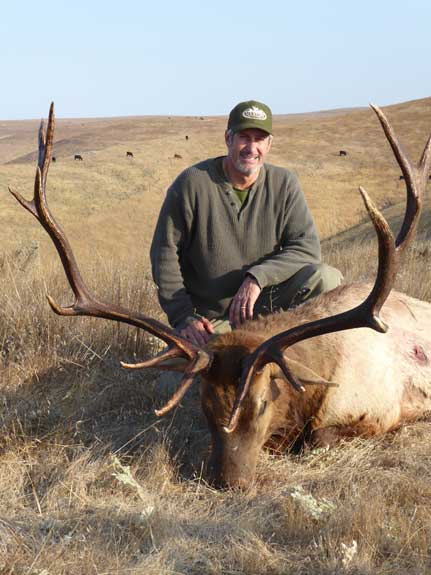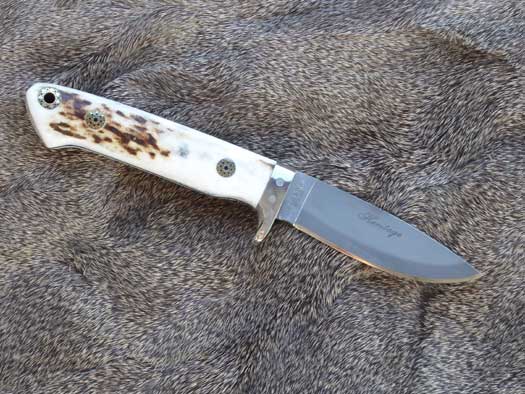Diamond Blade Knife honors legendary knife maker Robert “Bob” Loveless with the creation of the new Heritage fixed blade knife.

If memory serves well, the Diamond Blade knife line was initially exhibited at the 2006 SCI Convention, held in Reno, Nevada. The demand for the knives at that showing was so great that the company had a difficult time keeping its booth stocked. The real exciting aspect of the Diamond Blade knives was that the science behind this new knife line was the first real advancement in blade creation seen in many decades. At last, hunters could have both unrivalled sharpness and amazing edge retention in an edged tool that was tough enough to withstand the rigors of actual field use.
For those of you unfamiliar with the unique nature of Diamond Blade edged tools, they differ from the competition and how their actual creation came about. Several years before the knives made their initial appearance, Charles Allen, the owner of Knives of Alaska, thought that adding actual diamond bits to a basic steel formulation would enhance the cutting ability of knife blades made from steel. However, the process of steel manufacture actually turned the diamonds into simple carbon, which invalidated the whole theoretical concept.
Moving forward, Allen became intrigued with the friction forging process used in the oil industry that welds pipes together seamlessly. Experimenting with friction forging several different blade steel formulas, only D2 tool steel exhibited the increased performance Allen was seeking. Using a manufacturing process that combines both rotational heat and extreme pressure, the internal granular nature of the edge zone of a D2 blade is transformed in such a way that it becomes incredibly hard, and the contained chromium saturates the forged zone so that it becomes totally stainless.
While edge hardness in a knife blade is desirable, overall blade brittleness is not. Allen finally was able to produce a differentially heat-treated blade that combines an overall tough blade with a Rockwell hardness of Rc43-45, but with an edge zone featuring an enhanced hardness of Rc 65-68. Testing exhibited unparalleled performance with blades bent to more than 45-degrees from center without breaking or cracking. Likewise, the same blades are able to cut through hanging Manila rope easily and retain their edges even after repeated use.
Fast forward a dozen or so years and several Diamond Blade models, Allen decided to honor the memory of Robert “Bob” Loveless, one of the true legendary knife makers of the later half of the past century with the creation of one of his most desirable knife patterns. The result is a fixed blade knife known as the Heritage, that features a 3 1/2-inch drop-point pattern blade (Loveless is responsible for popularizing this particular blade shape), single guard, mosaic pins and your choice of handle materials (stag, Micarta, desert ironwood, ram horn, molded G-10 or a rubberized Sure Grip material), with a top grain, vegetable tanned, oiled leather sheath (Kydex lined). While a similar model bearing the original Loveless trademark will cost the buyer several thousand dollars, the new Diamond Blade version of the same knife runs $325 to $399 (depending on handle material choice) and offers both sharpness and edge retention well beyond anything Loveless ever imagined.

My own experience with this particular Diamond Blade model, as well as the knife line in general, has proven that these knives are “scary sharp” and they can hold that edge through repeated usage. Recently, I was able to participate in an elk hunt with the folks at Oak Stone Outfitters near Paso Robles, California. After two days of hard hunting, owner/operator Chad Wiebe was able to put hunter Mike Schultz on a fine 7×7 Tule elk. Since Chad Wiebe is not only a licensed guide, but also a professional taxidermist, his experience with various edged tools is second to none. During the time Chad used the knife to skin the elk, he repeatedly remarked on the superiority of its edge and how well that edge held up over time. Not once did Chad have to sharpen the knife. After the job was done, he wiped the blade clean and said, “This is the finest knife I’ve ever used.” Obviously, that is a great recommendation from a seasoned hunting professional.
Over and over again, Diamond Blade knives provide their users with remarkable performance that lasts through multiple use cycles. If you want to own a knife that has its origin in the hands of a legendary knife maker Bob Loveless, then the Diamond Blade Heritage is only choice. –Durwood Hollis
